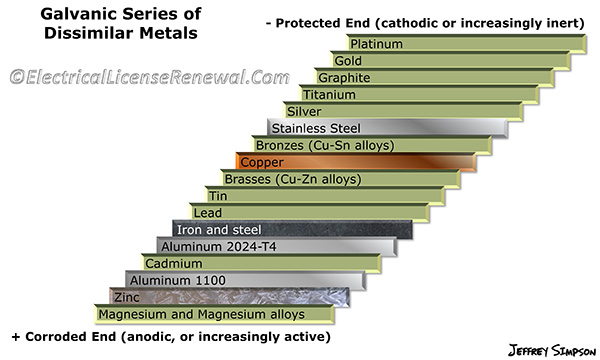358.14 Dissimilar Metals.

Code Change Summary: A new code section provides rules on the use of EMT with dissimilar metals.
The previous code language in 358.12 note 6 provided the requirements for EMT in contact with dissimilar metals but made no mention of stainless steel EMT at all. In the 2017 NEC®, most of 358.12 was turned into positive text and moved to 358.10 and the language on galvanic action of dissimilar metals was reworded and put into 358.14 which is a new section altogether.
In order for galvanic corrosion to occur, the following conditions must exist:
- There must two dissimilar metals in contact with one another; an anode (the less noble metal that will corrode) and a cathode (the more noble metal that will be protected through the corrosion process).
- There must be different corrosion potential between the anode and the cathode (see illustration).
- There must be an electrolyte (electrically conductive fluid) in contact with the two metals.
When the above conditions exist, the less noble metal (anode) deteriorates at an accelerated rate and deposits portions of itself onto the cathode as the anode tries to return to its original state before it was refined (ore).
In the 2017 NEC®, this code section changed to recognize the significance of the differences in electrical potential between the most commonly used materials for EMT which are galvanized coated (zinc) steel, aluminum and stainless steel.
Aluminum and galvanized steel are reasonably compatible with one another (see illustration) unless a corrosive agent is introduced which will accelerate the corrosion process. The closer the metals are together on the dissimilar metals chart, the slower the corrosion process will be when an electrolyte is introduced.
Stainless steel however, is pretty far up the chart when determining the corrosion potential of dissimilar metals. Because of the greater difference in potential between stainless steel and aluminum or stainless steel and galvanized (zinc) coated steel, stainless steel EMT shall only be used with stainless steel fittings and approved accessories, outlet boxes, and enclosures.
Similar code changes occurred in 342.14 for Intermediate Metal Conduit and 344.14 for Rigid Metal Conduit.
Below is a preview of Article 358. See the actual NEC® text at NFPA.ORG for the complete code section. Once there, click on their link to free access to the 2017 NEC® edition of NFPA 70.
2014 Code Language:
358.12 Uses Not Permitted.
(6) Where practicable, dissimilar metals in contact anywhere in the system shall be avoided to eliminate the possibility of galvanic action.
Exception: Aluminum fittings and enclosures shall be permitted to be used with steel EMT where not subject to severe corrosive influences.
2017 Code Language:
N 358.14 Dissimilar Metals. Where practicable, dissimilar metals in contact anywhere in the system shall be avoided to eliminate the possibility of galvanic action. Aluminum fittings and enclosures shall be permitted to be used with galvanized steel EMT, and galvanized steel fittings and enclosures shall be permitted to be used with aluminum EMT where not subject to severe corrosive influences. Stainless steel EMT shall only be used with stainless steel fittings and approved accessories, outlet boxes, and enclosures.